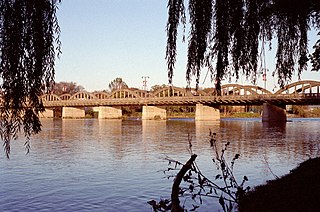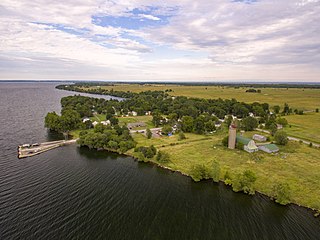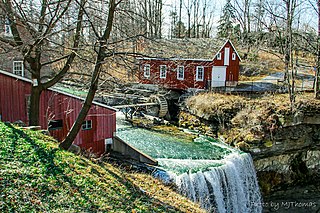
Greater Napanee is a town in southeastern Ontario, Canada, approximately 45 kilometres (28 mi) west of Kingston and the county seat of Lennox and Addington County. It is located on the eastern end of the Bay of Quinte. Greater Napanee municipality was created by amalgamating the old Town of Napanee with the townships of Adolphustown, North and South Fredericksburgh, and Richmond in 1999. Greater Napanee is co-extensive with the original Lennox County.

Haldimand County is a rural city-status single-tier municipality on the Niagara Peninsula in Southern Ontario, Canada, on the north shore of Lake Erie, and on the Grand River. Despite its name, it is no longer a county by definition, as all municipal services are handled by a single level of government. Municipal offices are located in Cayuga.

Norfolk County is a rural single-tier municipality on the north shore of Lake Erie in Southwestern Ontario, Canada with a 2016 population of 67,490. Despite its name, it is no longer a county by definition, as all municipal services are handled by a single level of government. The largest community in Norfolk County is Simcoe, whose 2016 population was 13,922. The other population centres are Port Dover, Delhi, Waterford and Port Rowan, and there are many smaller communities. For several years in the late 20th century, the county was merged with Haldimand County but the merged entity was dissolved in 2000.

Spadina Museum: Historic House & Gardens, also known as Spadina House, is a historic mansion at 285 Spadina Road in Toronto, Ontario, Canada, that is now a historic house museum operated by the City of Toronto's Economic Development & Culture division. The museum preserves the house much as it existed and developed historically. The art, decor and architecture of the house used to reflect the contemporary styles of the 1860s through the 1930s, including Victorian, Edwardian, Arts and Crafts, Art Deco, Art Nouveau and Colonial Revival styles. The museum closed for a year for extensive interior and exterior renovations. When it re-opened to the public on October 24, 2010, it was decorated in the style of the inter-war era of the 1920s and 1930s. The estate's gardens reflect the landscape during the Austin family's occupation of the house.

Black Creek Pioneer Village, previously Dalziel Pioneer Park, is an open-air heritage museum in Toronto, Ontario, Canada. The village is located in the North York district of Toronto, just west of York University and southeast of the Jane and Steeles intersection. It overlooks Black Creek, a tributary of the Humber River. The village is a recreation of life in 19th-century Ontario and gives an idea how rural Ontario might have looked in the early-to-mid-19th century. The village is a regular destination for field trips by schoolchildren from the Greater Toronto Area. It was opened in 1960 and is operated by the Toronto and Region Conservation Authority.

Loyalist is a lower-tier township municipality in central eastern Ontario, Canada on Lake Ontario. It is in Lennox and Addington County and consists of two parts: the mainland and Amherst Island. It was named for the United Empire Loyalists, who settled in the area after the American Revolution.

Amherst Island is located in Lake Ontario, 10 kilometres (6 mi) west of Kingston, Ontario, Canada. Amherst Island, being wholly in Lake Ontario, is upstream, above the St Lawrence River Thousand Islands. The Island is part of Loyalist Township in Lennox and Addington County. Amherst Island is located about 3 kilometres (2 mi) offshore from the rest of Loyalist Township and is serviced by public ferry from Millhaven. The Island measures over 20 kilometres (12 mi) in length from Bluff Point in the southwest to Amherst Bar in the northeast and over 7 kilometres (4.3 mi) at its widest point across. The Island is about 66 square kilometres (25 sq mi) in size and is one of the largest islands in the Great Lakes.
Horaceville is a historic site located on the Ottawa River in eastern Ontario, Canada. The site remained the property of the heirs of Hamnett Kirkes Pinhey until the 1970s, when the property was sold to the township. Today, The 88-acre (360,000 m2) heritage site is owned and operated by the City of Ottawa and Pinhey's home serves as a museum. The museum is open May 14 through August 31, Wednesdays to Sundays, 11 am to 5 pm. This location is also known as Pinhey's Point Historic Site. The property was designated by the City of Ottawa under Part IV of the Ontario Heritage Act as having cultural heritage value or interest. A bronze plaque erected on the site by the Ontario Heritage Foundation describes the property's history: "Hamnet Kirkes Pinhey 1784 - 1857 - A merchant and ship owner in his native England, Pinhey came to Upper Canada in 1820. For his services as King's messenger during the Napoleonic Wars, he received a 1000 acres land grant on the Ottawa River. Within a decade he had built up an estate which he named Horaceville after his elder son. In addition to a manor house and barns, it included mills, a store and church. Pinhey took a leading part in township and district affairs. He was appointed to the Legislative Council in 1847, served as Warden of the Dalhousie District, and as the first Warden of Carleton County. Horaceville remained in family hands until 1959 when it was purchased by the National Capital Commission."

The Ontario Heritage Trust is a non-profit agency of the Ontario Ministry of Tourism and Culture. It is responsible for protecting, preserving and promoting the built, natural and cultural heritage of Canada's most populous province, Ontario.

Grafton is a community in the province of Ontario. It is in Northumberland County, in the township of Alnwick/Haldimand. It is 12 km east of Cobourg, Ontario on the former Highway 2, with close access to Highway 401. The hamlet is near the geographically significant Oak Ridges Moraine at Rice Lake. Grafton was originally called Grover's Tavern until March, 1832. The original Grover's Tavern, the namesake building of the hamlet, still stands today as the Grafton Village Inn, a restaurant and B & B in the heart of the hamlet. It was also referred to early in its history as Haldimand, which is the name of the township it is located in.
The Haldimand County Museum & Archives, located at 8 Echo Street in Cayuga, Ontario, Canada, is a museum that preserves and makes accessible evidence of the history of Haldimand County. Artifacts related to Haldimand County are restored and displayed in the museum galleries and grounds. The current curator is Karen Richardson.

Delta, Ontario, is a community in the Township of Rideau Lakes, Leeds and Grenville County in Eastern Ontario. The village is located between two lakes, Upper Beverley and Lower Beverley, along highway 42, approximately 15 kilometres west of Athens, Ontario and 28 kilometres east of Westport, Ontario.

Merrickville–Wolford is a village-status municipality in Eastern Ontario, Canada, located in the United Counties of Leeds and Grenville. It spans both shores of the Rideau River.
Carleton Island is located in the St Lawrence River in upstate New York. It is part of the Town of Cape Vincent, in Jefferson County.
Benjamin Ewing was a farmer, businessman and political figure in Upper Canada. He represented Northumberland in the Legislative Assembly of Upper Canada in 1825 and from 1828 to 1830.

Lang Pioneer Village Museum is a living history museum located in the hamlet of Lang in Peterborough County, Ontario. It was established in 1967 by the County of Peterborough. Lang Pioneer Village is situated on the shores of the historic Indian River. Lang Pioneer Village is an "outdoor museum" featuring more than 30 restored and furnished buildings, many of which were donated from the surrounding townships. The buildings, constructed between 1820 and 1910, are interpreted by costumed villagers portraying authentic 19th-century pioneer life. Since 2014 the Museum has been the site of the Aabnaabin Encampment, a pre-colonization representation of a Michi Saagiig camp where the story of the First Nations history and culture of the region is told by indigenous interpreters. Lang Pioneer Village Museum is owned and operated by the County of Peterborough.

The Domus Romana, stylized as the Domvs Romana, is a ruined Roman-era house located on the boundary between Mdina and Rabat, Malta. It was built in the 1st century BC as an aristocratic town house (domus) within the Roman city of Melite. In the 11th century, a Muslim cemetery was established on the remains of the domus.
David Thompson was an entrepreneur and a political figure in Canada West. He represented Haldimand in the Legislative Assembly of the Province of Canada from 1841 to 1851 as a Reformer.

Waterloo Park is an urban park situated in Waterloo, Ontario, Canada on land within Block 2 of the Haldimand Tract. Spanning 111 acres within the Uptown area of Waterloo, it opened in 1893 and is the oldest park in the city. Managed by the City of Waterloo, the park contains numerous recreational amenities including athletic fields, baseball diamonds, playgrounds, a skateboard park, and the Laurel and Trans Canada trails.

Morningstar Mill is a 2.98-acre (1.21 ha) heritage site located in St. Catharines, Ontario, Canada. The site includes the Morningstar Mill, a sawmill, the home of the Morningstar family, a barn used for blacksmith demonstrations, and the Decew Falls gorge along the Niagara Escarpment.
















